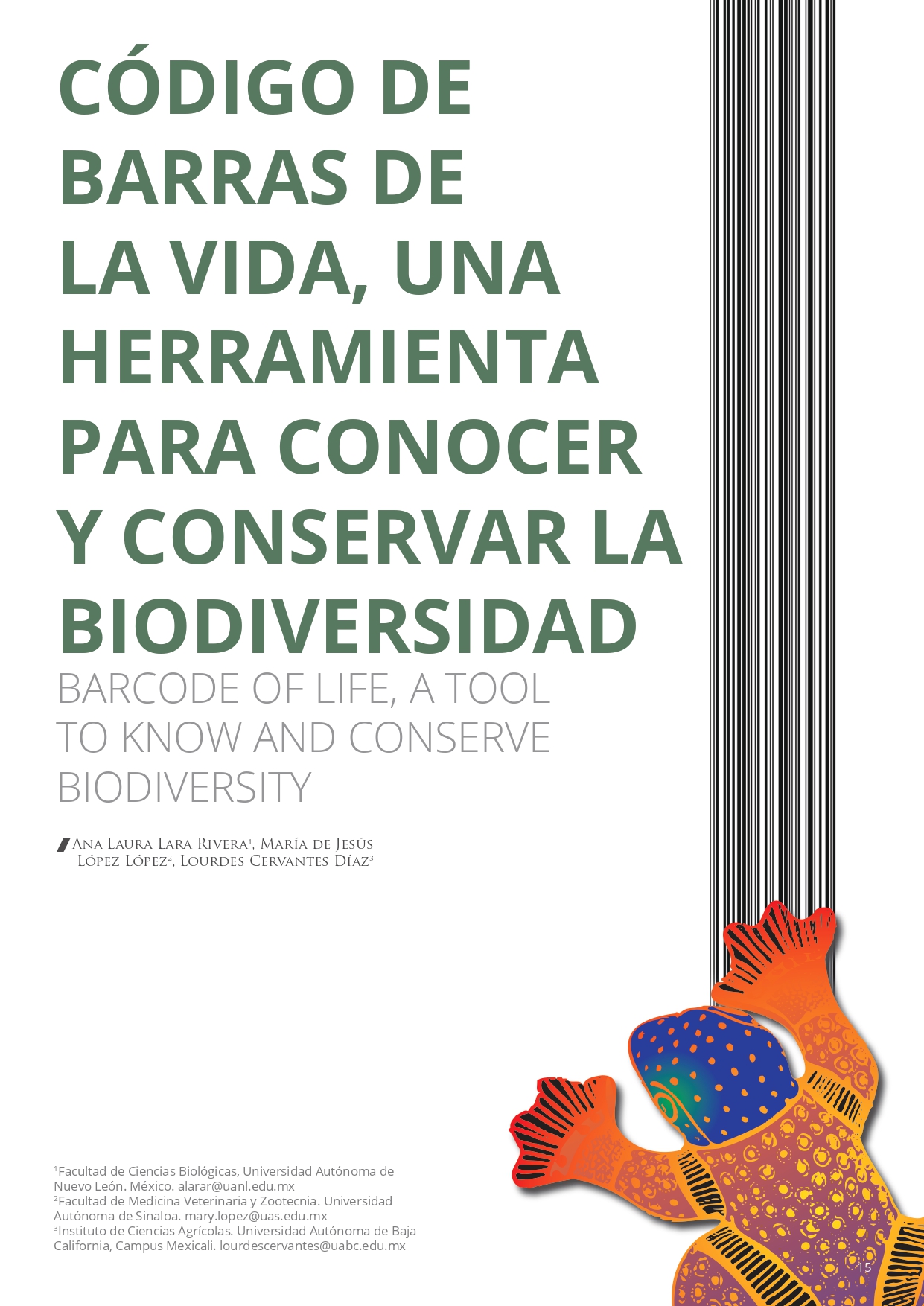Barcode of life, a tool to know and conserve biodiversity
DOI:
https://doi.org/10.29105/bys7.13-102Keywords:
Barcodes of Life, Biodiversity, Organism identification and classificationAbstract
Traditional identification, taxonomy, and classification of living organisms require extensive training and knowledge in taxonomic keys and face challenges such as the complexity of identifying organisms in immature stages, sexual dimorphism, and cryptic species, among others. The application of molecular analysis technologies presents a new era of possibilities for solving these problems; That is why in 2010 the International Barcode of Life Consortium (iBOL) established a global initiative to build a reference library of freely accessible DNA barcodes for the identification of living organisms. To date, this initiative has permitted to establishment of collaboration networks that have led to the resolution of problems in traditional taxonomy, as well as the scope of new challenges focused on the preservation of endangered species.
Downloads
References
Iternational Barcode of life. En: https://ibol.org/. Accesado en enero de 2023.
Baker C.S., S.R. Palumbi. 1994. Which whales are hunted? A molecular genetic approach to monitoring whaling. Science. 265:1538–1539. https://www.science.org/doi/10.1126/ science.265.5178.1538 DOI: https://doi.org/10.1126/science.265.5178.1538
Brusca, R.C., & G.J. Brusca. 2003. Invertebrates (Inc. Sinauer Associates Ed. Segunda ed.). 25 pp.
Brown J.H. & M.V. Lomolino. 1998. Biogeography. Sunderland (MA): Sinauer Associates. https://doi.org/10.1002/mmnz.20000760118. DOI: https://doi.org/10.1002/mmnz.20000760118
Elias-Gutierrez, M., F.M. Jeronimo, N.V. Ivanova, M. Valdez-Moreno & P.D. Hebert. 2008. DNA barcodes for Cladocera and Copepoda from Mexico and Guatemala, highlights and new discoveries. Zootaxa, 1839(1), 1-42. DOI: https://doi.org/10.11646/zootaxa.1839.1.1
Etzler, F.E., K.W. Wanner, A. Morales-Rodriguez & M.A. Ivie. 2014. DNA barcoding to improve the species-level management of wireworms (Coleoptera: Elateridae). Journal of Economic Entomology, 107(4), 1476-1485. https://doi.org/10.1603/EC13312. DOI: https://doi.org/10.1603/EC13312
Gonçalves, P.F., A.R. Oliveira-Marques, T.E. Matsumoto & C.Y. Miyaki. 2015. DNA barcoding identifies illegal parrot trade. Journal of Heredity, 106(S1), 560-564. https://doi.org/10.1093/jhered/esv035. DOI: https://doi.org/10.1093/jhered/esv035
González-Solís, D., M. Elías-Gutiérrez, J.A. Prado-Bernal, & M.A. García-de la Cruz. 2019. DNA barcoding as a diagnostic tool of a rare human parasitosis: the first case of Lago chilascaris minor in Quintana Roo, Mexico. Journal of Parasitology, 105(2), 351-358. https://doi.org/10.1645/18-129 DOI: https://doi.org/10.1645/18-129
Hebert, P.D., & T.R. Gregory. 2005. The promise of DNA barcoding for taxonomy. Systematic biology, 54(5), 852-859. https://doi.org/10.1080/10635150500354886. DOI: https://doi.org/10.1080/10635150500354886
Irinyi, L., C. Serena, D. Garcia-Hermoso, M. Arabatzis, M. Desnos-Ollivier, D. Vu & W. Meyer. 2015. International Society of Human and Animal Mycology (ISHAM)-ITS reference DNA barcoding database—the quality controlled standard tool for routine identification of human and animal pathogenic fungi. Medical mycology, 53(4), 313-337. https://doi.org/10.1093/mmy/myv008. DOI: https://doi.org/10.1093/mmy/myv008
Ivanova, N.V., A.V. Borisenko & P.D. Hebert. 2009. Express barcodes: racing from specimen to identification. Molecular ecology resources, 9, 35-41. https://doi.org/10.1111/j.1755-0998.2009.02577.x DOI: https://doi.org/10.1111/j.1755-0998.2009.02630.x
Lecona Urrutia, A.A. 2014. Biología I (MCGRAW-HILL INTERAMERICANA Ed. Segunda ed.). 130-133 pp.
Mondol S., V. Sridhar, P. Yadav, S. Gubbi & U. Ramakrishnan. 2014. Tracing the geographic origin of traded leopard body parts in the Indian sub-continent with DNA-based assignment tests. Consev Biol. https://doi.org/10.1111/cobi.12393. DOI: https://doi.org/10.1111/cobi.12393
Schwarz C., R. Debruyne, M. Kuch, E. McNally, H. Schwarcz, A.D. Aubrey, J. Bada & H. Poinar. 2009. New insights from old bones: DNA preservation and degradation in permafrost preserved mammoth remains. Nucleic Acids Res. 37:3215–29. https://doi.org/10.1093/nar/gkp159 DOI: https://doi.org/10.1093/nar/gkp159
Valdez-Moreno, M., N.V. Ivanova, M. Elías-Gutiérrez, S. Contreras-Balderas, & P.D.N. Hebert. 2009. Probing diversity in freshwater fishes from Mexico and Guatemala with DNA barcodes. Journal of Fish Biology, 74(2), 377-402. DOI: https://doi.org/10.1111/j.1095-8649.2008.02077.x
Valdez-Moreno, M., C. Quintal-Lizama, R. Gómez-Lozano & M.D.C. García-Rivas. 2012. Monitoring an alien invasion: DNA barcoding and the identification of lionfish and their prey on coral reefs of the Mexican Caribbean. PloS one, 7(6), e36636. DOI: https://doi.org/10.1371/journal.pone.0036636
Valdez-Moreno, M., N.V. Ivanova, M. Elias-Gutierrez, S.L. Pedersen, K. Bessonov & P.D. Hebert. 2019. Using eDNA to biomonitor the fish community in a tropical oligotrophic lake. Plos one, 14(4), e0215505. DOI: https://doi.org/10.1371/journal.pone.0215505

Downloads
Published
How to Cite
Issue
Section
Categories
License
Copyright (c) 2024 Ana Laura Lara Rivera, María de Jesús López López, Lourdes Cervantes Díaz

This work is licensed under a Creative Commons Attribution 4.0 International License.





